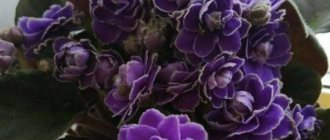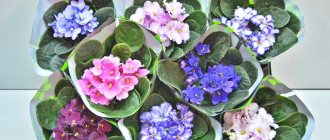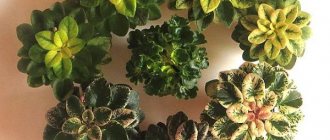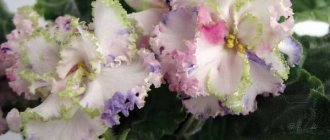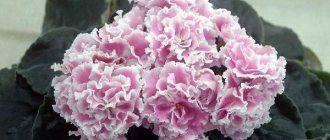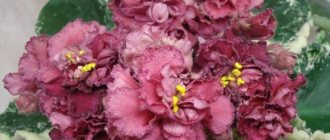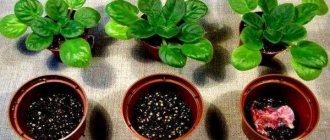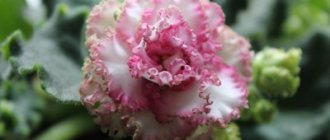The African violet first appeared in the 90s of the nineteenth century. More precisely in 1893 at a flower exhibition.
The famous botanist Hermann Wendland named the plant grown from seeds Saintpaulia ionantha (Saintpaulia violet).
It is often called African or Uzambara violet among gardeners:
- Even today there are just over 20 species . But in apartments on the windowsills it’s even difficult to count them. They name the numbers. Even more than 30 thousand varieties. Their creators could hardly have predicted their enormous popularity;
- How they conquered flower growers: Many varieties with beautiful combinations and colors of flowers and leaves;
- Very easy to grow indoors;
- Experts also like the opportunity to develop new varieties.
- Graduated from the Faculty of Automation and Computer Science at the Samara Polytechnic Institute. He runs a shoe company. And makes violets for the soul;
Beautiful violet. Artist's masterpiece.
Burgundy violets
The violet with blue flowers is the progenitor of all subsequent generations.
Breeders are constantly working to develop new colors of Saintpaulia. The most difficult ones are green and yellow. Burgundy violets are very popular. They can be single-colored or consist of 2 or more colors. Chimeras and violets with imprints are prized.
In appearance, burgundy violets have one of the following forms:
- pansies;
- stars;
- bells;
- bowls;
- wasps.
According to terryness there are:
- simple;
- scallop;
- semi-double;
- terry;
- in the form of carnations.
Classification according to the degree of doubleness of the flower.
The decoration of burgundy violets is a border and fringe.
Important! Thanks to the variety of shapes and colors, everyone can find their own unique Saintpaulia.
With flower prints
Below you will see photos of burgundy violets with spots and splashes of various colors on the petals.
Glimmar
The author of the delicate, fragile Saintpaulia is Kent Stork, a breeder from the city of Fremont (Nebraska, USA).
The variety does not cause problems in care and maintenance. Does not like changes in lighting and temperature.
The flowers are in the form of simple stars, the color of the petals is fuchsia-red fingers on a light background. Blooms powerfully. Peduncles are quite strong.
The leaves are dark green. The socket is large, smooth, nice, standard.
RM-Amalia
The owner of this beauty is a breeder from Kursk, Natalya Skornyakova. RM-Amalia grows easily and blooms quickly.
Flowers are in the form of simple large stars (up to 7.5 cm). Petals with a wavy structure, white with bright cherry imprints. It blooms very impressively and profusely. It blooms with a beautiful hat. Color appears most vividly at high temperatures.
Leaves are green. The socket is standard, flat.
EK-Shanghai rose
The author of this unusually beautiful variety is Elena Korshunova. This is a sport from the EK-Gardens of Babylon variety.
The flowers of the Shanghai rose are similar to a rose - huge, airy, with a dense structure. The color is not too bright, dark red. The petals are decorated with a wide white border. The peduncles are strong, droop slightly, but bear flowers well.
They love light very much. It is better to use wick watering.
The leaves are green and pointed. The socket is neat, for display. Easy to put on.
RS-Duchess
The author of the luxurious lady is Svetlana Repkina (Lugansk). The variety is hardworking and blooms profusely. Tolerates heat well.
The first flowering may not meet your expectations, remain patient - everything has its time. Maybe go into sports.
The flowers are luxurious, very large semi-double and double, the color is white with plum prints. The petals are corrugated and airy. The balloons form a lush, beautiful bouquet.
The leaves are quilted, the color is medium green, quilted. Standard socket.
With border
This section presents the names of burgundy violets with a white border.
Powder Keg
The author of the elegant violet is breeder Paul Sorano. It grows slowly. Blooms for a long time.
The flowers are quite large stars, semi-double or double, the color is bright dark red with a white border. Wavy petals. At the first flowering, the peduncles are low, at the second they become longer.
When there is insufficient lighting, the color becomes darker.
The leaves are dark green, with red on the reverse side. Socket up to 45 cm, large standard.
Red Lantern
The author of the Red Lantern variety is breeder Paul Sorano. It exhibits varietal characteristics well, is unpretentious in care, and reproduces easily.
The flowers are beautiful, semi-double, velvety stars, the color is rich dark red, may have a slightly noticeable pearlescent tint, the border is white. This dark burgundy violet blooms for quite a long time.
The leaves are dense, dark green, and red on the reverse side. Great standard.
Emergency
The author of this elegant variety is Kent Stork, a breeder from the city of Fremont (Nebraska, USA).
The flowers are semi-double pansies, the color is bright red. The petals have a clear white border. Peduncles are slightly long. Blooms profusely.
The leaves are bright, dark green. The socket is standard. Sometimes it lifts leaves up.
Attention! It does not require special care. Loves natural light, in bright light it becomes more terry.
Arcturus
The author of this bright variety is the breeder J. Eyerdom. The flowers are similar to Emergency, but lighter, bloom more luxuriantly and profusely. Propagates easily. Loves light.
The flowers are semi-double, dark red in color with a white border. Petals with wavy.
The leaves are ordinary, dark green, juicy, and may have a yellow tint. Standard socket.
Reviews
Alevtina Georgievna. “I want to immediately reassure some lovers about the blooming of the Shanghai rose. You may not see fully adequate flowering in the first year. And the exact color of the flowers. The first flowers are not even big enough. I went through all this. Let's have more light. And the flower stalks will stand with huge flowers. Don’t lie around the socket.”
Alexander. “The white border did not appear on my first flowers. The result is a violet from the Gardens of Babylon. Someone told me about this once. She is very beautiful. And I prefer large and hanging flowers. This is not just my opinion. My friends are of the same opinion. And the lack of a border doesn’t upset me.”
The presented variety attracts the attention of many gardeners.
Oleg. “Every time it blooms there are some new colors. And with trepidation you prepare for its new flowering. There will definitely be a surprise. After all, it was red and white. And red and white. I advise more light and use wick watering. You will see the difference yourself.”
Propagating violets at home: 2 ways
Basically, Saintpaulias are bred with leaves, segments from plates, and rosettes. And although this can be done all year round, experts say that it is still better to propagate the plant in spring or summer. This is due to the fact that during this period there is more heat and light - necessary factors for the rapid rooting of planting material.
Leaf
Leaf propagation is the simplest method. Cut the plate under the peduncle from a completely healthy plant. The cut needs to be dried for about half an hour. Fill a small dark glass jar (you can use a pharmacy bottle) with cool boiled water and activated carbon powder.
Cover the top with film, cut a hole and stick a leaf into it. When the roots appear, move them into the soil. A greenhouse can be easily made from a plastic bottle. The babies will arrive in a couple of weeks. You need to wait until the leaves reach 1 cm in diameter and plant them in pots.
By division
In pots with violets, several leaf rosettes are often formed at once. They are separated with a well sharp knife. At least a small spine remains on each part. The delenki are immediately planted in the ground.
This video shows the transplantation of Uzambara violet (Saintpaulia) babies.
Methods and methods of propagation of the variety
It is recommended to propagate the Shanghai rose violet variety vegetatively, using leaf cuttings or daughter rosettes. Propagation by leaf parts and the seed method are rarely used. They are labor-intensive and time-consuming, and varietal characteristics may not be preserved in young plants.
Propagation by leaf cuttings
For this propagation method, large, healthy leaves are used. They need to be carefully cut, the cut areas sprinkled with crushed activated carbon and planted in a container with nutritious soil. The plantings must be watered, covered with polyethylene film and sent to a well-lit, warm room.
[adsp-pro-6]
With proper care, new, young plants should appear in a few months. Once they have grown enough, they need to be transplanted into separate containers.
Important! You can also place cut violet leaves in a cup of water in which a growth stimulator is dissolved. After the roots appear, they are planted in a nutrient mixture.
Shanghai rose violet can be propagated by rooting a healthy leaf.
Propagation by leaf rosettes
With this propagation method, you need to select well-developed leaf rosettes and carefully separate them from the daughter plant. In this case, it is advisable to preserve the roots on them. After this, they should be distributed into separate small pots, slightly moistened and covered with glass containers.
They need to be removed periodically to evaporate condensation and water the plants, and after rooting is completed and new leaves appear, they must be removed completely.
Features of care
Nuances of conditions of detention
There are no special conditions for growing the bulk of large-flowered violets. The main and most important requirements are for:
- pot size;
- quality and composition of the soil;
- lighting;
- temperature;
- choice of fertilizers;
- compliance with the irrigation regime.
Only some species prefer a slight decrease in temperature for a more saturated flower color or bud formation.
How to water correctly?
One of the main components of successful cultivation of large-flowered Saintpaulia species is compliance with the correct watering regime.
Like almost all types of violets, large-flowered ones are afraid of drying out and waterlogging of the soil. Therefore, you should not overdo it with watering.
The violet should not be over-watered or over-dried.
Advice! It is better to water through a tray or in small portions through the top along the edge of the container, without getting on the flowers or buds.
The frequency and volume of watering depends on several factors:
- season;
- age condition;
- the size of the container in relation to the size of the plant;
- temperature and humidity in the growing room;
- quantity and saturation of lighting;
- quality and composition of the soil.
On average, according to the recommendations of experienced gardeners, watering is carried out:
- 2-3 times a week in the summer;
- once a week in winter.
Do not forget about the quality of water for irrigation. It should be clean, soft and warm.
Lighting
The duration of daylight hours should be about 12 hours per day. But at the same time, direct sunlight should be avoided on the plant, and diffused light should be provided.
If it is impossible to provide the flower with this amount of daylight, it is better to use additional light sources, such as phytolamps.
Illumination of violets.
Important! We should not forget about resting the plant. Daylight hours should not be increased beyond 14 hours.
Nature of feeding
Additional nutrition depends on the growing season and the structure of the leaf blades. At each phase of the growing season, a certain composition of fertilizers should be applied. For large-flowered specimens, additional nutrition occupies a special place.
For full flowering of flowers of this size, the necessary composition of fertilizers, both organic and mineral, containing a full range of necessary micro- and macroelements, should be applied in a timely manner.
The soil of a newly transplanted violet becomes depleted approximately a couple of months after transplantation. From this moment on, you should add the entire complex of substances necessary for the plant for full development, growth and flowering.
In addition to the complex of basic elements - nitrogen, phosphorus and potassium in the ratio NPK: 20:20:20, the composition should also include trace elements: Ca, Fe, Mg, Mo, B, Na, Cu, Z and S.
The first nutrition is applied in the spring after the plant awakens. During this period, complexes with a high nitrogen content are used.
In the phase of budding and rosette formation, fertilizer complexes with a predominance of potassium and phosphorus are required.
Subsequent feeding is carried out with fertilizers for violets with an equal ratio of micro- and macroelements.
Reproduction
For garden large-flowered violet feeds, propagation or reproduction of new planting material is carried out by seeds, cuttings or dividing the bush.
Propagation of indoor violet (Saintpaulia) is mainly carried out by leaf cuttings, rooting them in water or substrate and then planting the children.
Reproduction by cuttings step by step.
There are varieties that reproduce very well, but there are also those that you need to tinker with, ensuring quality with quantity and creating the necessary conditions. But, basically, large-flowered species are propagated in the same way as ordinary standard specimens.
Transplantation without damaging the root system
A violet is planted in a permanent pot only after its rosette reaches 8-10 cm in diameter, or when the roots are very tightly entangled in an earthen ball. In the latter case, if the glass was very small, there is no need to rush to transplant the violet directly into a large pot; it is better to plant it in a container that is 2-3 cm larger.
Transshipment of violets.
When transshipping a young plant, in order to injure the roots less, you can use the following method:
- Take a pot of larger diameter. Place expanded clay on the bottom;
- Pour some soil and place a container of smaller diameter in a new pot;
- Fill the container around the circumference with the substrate, compacting it by tapping;
- Pull out the old pot, and place an earthen lump with a violet into the resulting recess.
How long it takes for a leaf violet to bloom depends on many factors. To ensure that less time passes from planting a leaf to flowering, the following must be taken into account:
- when planting in the ground, the petiole does not need to be buried - it will be easier for young shoots to sprout;
- there should not be large temperature differences day/night;
- It is best to grow under artificial lighting on a shelf so that there is no excess or lack of light;
- greenhouses must be ventilated;
- if the rooted leaves grow on their own without sprouting, then you need to cut off the top of the leaf plate by 1/3 and sprinkle the cut with activated carbon;
- In order not to confuse which variety was planted and when, it is necessary to make appropriate notes on cups or stickers.
Pros and cons of propagation by leaves
Any strong leaf without signs of disease or spoilage can become an excellent material for vegetative propagation of a Saintpaulia rosette. The optimal time is March, when there is no heat and the days are longer. But as an emergency rescue measure, the method can be used almost year-round.
Pros:
- material is always at hand;
- large output of children: from one sheet to several dozen rosettes;
- practically guaranteed results if you follow simple rules;
- can be carried out all year round.
Minuses:
- Rooting in March gives the best results;
- violation of the maintenance regime will lead to the death of both the leaf and the children;
- The minimum time to receive children is two months.
Having gained experience on how to plant violets in a pot with a leaf, in the future you can repeat it as many times as you like, noticing additional nuances.
Sources
- https://komnatnie.com/fialki/uhod-fialki/posadka-f/iz-lista-v-domashnih-usloviyah.html
- https://sadovnikam.ru/415084a-razmnojenie-fialki-listom-prakticheskie-sovetyi
- https://kursi-floristiki.ru/komnatnye-cvety/kak-posadit-fialku.html
- https://ogorod.plus/razmnozhenie-fialok-v-domashnih-usloviyah/
- https://pocvetam.ru/komnatnye-rasteniya/tsvetushchie/kak-razmnozhit-fialku.html
- https://pahistahis.ru/2019/08/18/kak-ukorenit-list-fialki-luchshie-sposoby/
- https://stroy-podskazka.ru/senpolii/razmnozhenie-iz-lista/
- https://sadovnikam.ru/431836a-razmnojenie-fialok-listom-v-domashnih-usloviyah-poshagovo-poryadok-deystviy-sovetyi-otzyivyi-foto
- https://ProZvety.ru/katalog-rastenij/krasivotsvetushhie/kak-razmnozhit-fialku-listom
- https://sadovnikam.ru/416888a-kak-vyirastit-fialku-razvedenie-poshagovaya-instruktsiya-razmnojenie-fialki-listom-posadka-ukorenenie-i-uhod
- https://komnatnie.com/fialki/uhod-fialki/razmn/listom-v-domashnih-usloviyah.html
- https://glav-dacha.ru/razmnozhenie-fialok-listom/
- https://komnatnie.com/fialki/uhod-fialki/virashivanie-f/iz-listochka.html
- https://pocvetam.ru/komnatnye-rasteniya/kak-vyrastit-fialku-iz-listocka-v-domasnih-usloviah.html
Care and cultivation of violets at home
It is believed that Saintpaulia is quite demanding in care. In fact, to ensure abundant flowering, you just need to establish a regime of watering, fertilizing, and choose the right nutrient substrate.
Temperature
The most comfortable temperature for growing homemade Saintpaulias is considered to be from +18 to +25 °C. When the thermometer is above or below the specified standards, the flower will begin to fade and shed its leaves.
It is not recommended to place plants in bright sunlight - delicate leaves can get burned. In summer, you should choose windows facing north for violets, and in winter, windows facing south.
Advice! If it is not possible to move the flowers from the sunny side, you should shade the violet. For this, blinds that control the light intensity, window foil, and newspapers can be used.
Soil for violets
Although the houseplant prefers nutritious soil, planting flowers in black soil is not recommended. The best option would be light peaty substrates. Loose soil allows moisture to pass through well and does not allow liquid to stagnate.
There are several valid options:
- A mixture of 4 liters of peat, 4 liters of vermiculite, 1 tbsp. dry mineral fertilizer, 1 tbsp. dolomite flour.
- A mixture of equal parts of leaf soil, garden soil, sand, sphagnum moss.
- Peat mixed with turf soil, manure humus, sand, sphagnum moss. All components must be mixed in equal proportions.
Flower shops offer ready-made soil mixtures for violets. You can mix the soil yourself according to one of the given recipes.
Watering
Violets need the greatest amount of moisture in the summer, during the flowering period, when the root system is developed. It’s easy to determine the need to moisten the soil - just feel and assess the condition of the top layer of soil.
Several watering methods:
Classic application of water under the stem
It is important to prevent moisture from getting inside the outlet.
Watering into the pan. The Saintpaulia root system itself will take the right amount of moisture.
Wick method
When replanting, a fabric strip that acts as a wick is placed inside the pot. The container with the flower is placed in a larger flowerpot; there should always be water in it. With the help of a wick, the Saintpaulia root system will absorb the required amount of liquid.
Important! Excessive watering can cause roots to rot. The violet will die.
How to fertilize violets?
It is recommended to choose complex liquid fertilizers for Saintpaulias as nutritional supplements. The concentrate must be diluted in the amount specified on the packaging by the manufacturer.
During the flowering period, it is necessary to water violets every 7–10 days with fertilizer.
If there are no flowers or buds, you need to reduce the application of fertilizers to once every 20–25 days.
Transplanting violets
Replacing the violet pot is only necessary if necessary. Experienced flower growers note that violets are abundantly covered with corollas if kept in a small pot. In this case, the flower does not waste energy on the formation of the root system, leaving energy for flowering.
Saintpaulias are transplanted in the spring, provided there are no flowers or buds on the plant. The new pot should be 0.5–1 cm wider than the previous one. Transplantation is carried out using the method of transshipment of an earthen clod. There is no need to remove old soil from the roots, as you can accidentally damage them.
Fragments of polystyrene foam and small pebbles are placed at the bottom of the new pot to ensure drainage. The plant is then moved from the old pot to the new one. After this, you need to add soil and lightly press it down.
Immediately after transplanting, you need to water the plant.
How to trim?
Violets do not require regular pruning. Leaves can be removed only in case of disease or for subsequent propagation.
How to propagate?
The Saintpaulia leaf, no matter what condition it is in (freezing, rotting, torn in half), is suitable for violet propagation. In the propagation process, the entire leaf plate, with the stalk (leg) or parts thereof, is used.
It is important that the veins from which the future rosette of the flower is formed are preserved on the leaf, but, as a rule, plants obtained in this way are small in size, stunted in growth, and they are also slightly weaker than crops obtained by other methods
To propagate a violet using a cutting, the rooting methods using water or soil described above are used.
With the help of stepchildren
This method is used when it is not possible to root a whole cutting, or when purchasing rare and other varieties by mail.
If the substrate contains a large amount of nitrogen, small shoots are formed in the axils of the Saintpaulia leaf blades - stepsons or daughter rosettes. Stepchildren are used to propagate violets by separating the parent plant from the plant while retaining 4-5 leaves per shoot. Rooting of the stepson occurs in moist, loose soil with the addition of sphagnum moss in a container with a lid or in one that can be covered with a plastic bag or plastic bottle.
After the rooting process (the shoot begins to grow), the young plant must be transplanted to a permanent place in a small pot. The duration of rooting of a stepson is on average 2 months.
By sheet segments
The main rule when carrying out any manipulations with a plant is that the instrument must be sterilized and sharply sharpened. If there are traces of rot on the leaves, the blades should be wiped and disinfected after each procedure using alcohol or manganese. If possible, the cut line should not severely damage the lateral veins. Each resulting segment from a leaf is capable of producing a baby - a rosette of leaves.
Let's consider the process of forming segments.
The central vein is cut out of the leaf, the resulting halves are divided into three parts, preserving the lateral veins (lines running from the central vein to the edges of the leaf). A fragment from the top of the leaf has a higher chance of rooting. In any case, a daughter rosette is formed from each resulting segment.
Another way is to cut the sheet in half. The upper and lower fragments are placed in the prepared earthen mixture. If rotting occurs on the cuttings, it is necessary to remove the infected areas to healthy tissue, trying to preserve the veins.
After the segments are formed, each piece of leaf is left in air at room temperature for 20 minutes. The sections must dry and be covered with a film; only after this the fragment is planted in the substrate, followed by processing in a solution of potassium permanganate.
Potassium permanganate is diluted in water, leaf segments are lowered into this liquid one by one for 15 minutes, after the procedure, the sections are treated with activated carbon. This method is intended to minimize the risks of fungal and other diseases during the formation of the root system of the future plant, accelerating the process of root growth.
After processing the sections, the leaves dry naturally and then are placed in prepared containers under the greenhouse. Brick chips, foam balls, broken tiles, and so on are suitable for drainage.
With the help of flower stalks
The peduncles of the mother crop are suitable for growing a new plant. For the procedure, fresh, young, dense peduncles are selected, filled with juice, without defects, rot or other flaws. On the selected segment, all flowers and ovaries are removed, the stem of the peduncle is shortened to 1 cm, shoots with buds are shortened to 5 mm, the first pair of leaves is cut to half the length.
A prepared small container is filled with substrate. The cuttings are air-dried for half an hour. The soil is spilled with clean water, and a small hole is dug in the center. The cuttings are buried in the planting zone up to the level of the leaves (the leaf plates should touch the soil mixture or be slightly immersed in it).
The pot is placed in greenhouse conditions. After a month and a half, a new outlet is formed. As the plant develops, flower ovaries will form that must be removed. After about 3 months, the plant will be ready to be transplanted into a permanent pot.
Origin and characteristics of the flower
The flower was first discovered in 1892 in eastern Africa by Governor and Baron Adelbert Walter von Saint-Paul during an afternoon walk. Noticing an unusual purple flower, he collected the seeds and sent them for research to his father in Germany, who forwarded the parcel to the director of the botanical garden in Hanover, who examined the plant and named it part of the Gesneriaceae family.
In 1893, the plant was already showing off at flower exhibitions and was officially recognized. Since then, the beautiful, tropical flower has spread and began to be grown as pets in many countries.
External description and photo
Saintpaulia is a perennial tropical herbaceous plant with beautiful flowers. The root system is poorly developed and has a fibrous type; the stems can be basal or with hanging rosettes. Depending on the variety, the diameter of the rosette varies from 6 to 55 cm. Externally, the flower can be described as follows:
- The leaves are round, fleshy, juicy, veins are clearly visible along the length of the leaf, the edge of the leaf is sharp or rounded. The surface is covered with small fibers that look like needles. The shade of the leaves is mainly dark green, but there are specimens with a light core (pink, cream, salad), some species have a red tint. The reverse side is light, silver-green. The coating can be smooth, matte or corrugated with convex tubercles.
- Stems are brown or dark red, succulent, straight. The bud stems branch into up to 15 small shoots with flowers.
- The flowers are simple with five petals and two stamens, collected in racemes. Depending on the variety, the buds are simple or double.
- The seed box is round with the presence of small seeds and gradually collapses under the influence of moisture. Botanists who breed plants and breed new varieties every year can tell you everything about indoor violets.
https://youtube.com/watch?v=wpizn24p6uc
If the plant does not take root
Perhaps the planting material was unsuitable - the old, lower leaves do not take root well. It is advisable to take young leaves for propagation.
For rooting, diffused lighting and fresh air are important. It is necessary to move the containers to a brighter place or use additional lighting. The substrate should not be sprayed; water should be carefully added to the tray only after the soil has completely dried
There should be drainage holes at the bottom of the container. If air permeability is poor, leaf rooting is problematic
The substrate should not be sprayed; water should be carefully added to the pan only after the soil has completely dried. There should be drainage holes at the bottom of the container. If air permeability is poor, leaf rooting is problematic.
To prevent the fungus from destroying the sprouts, the soil must have good water permeability. Do not add turf soil to the soil mixture. Also, you should not feed the sprouts with organic fertilizers. Successful breeding of echeveria requires certain knowledge, effort and skill. It is necessary to create conditions for the rooting and further development of young shoots.
The best varieties of violets: description
Violets can differ greatly from each other in size, in the shape of the flowers, and also in many other characteristics - growth rate, abundance of flowering, reaction to certain conditions.
In this article, we will help flower growers understand the complexity of the classification of violet species, we will talk about the most common, original and unique varieties, their characteristics and differences from many other crops. This article will be very dense due to the amount of information, but we will try to structure it to make it more interesting for the gardener.
Saintpaulias, also known as indoor violets, are plants belonging to the clear-flowered order, the genus Saintpaulia. Due to the fact that these flowers in appearance are really very reminiscent of a real violet (viola), it is often confused with violet, and is also called African violet - in accordance with the area where Saintpaulia was first discovered at the end of the 19th century . In this article, we will still call the plant a violet, since it will be more convenient to perceive information and immediately form an image of this unusual, but very attractive plant.
Let's talk a little about what varieties of violets and species are distinguished in floriculture today.
In general, the natural distribution area of wild Saintpaulias is limited to mountainous areas, mainly Tanzania or Kenya, since in that environment the plantings feel most comfortable, it is very easy for them to grow and develop, because the air temperature and humidity are ideal.
Wild violets are also found near river banks, near waterfalls or in ravines, in the partial shade that comes from large trees. The violet does not tolerate direct sunlight at all, as it simply dies under it.
If we talk about how many species of Saintpaulia grow today in their natural habitat, then experienced gardeners count about twenty main species. We will introduce you to some of them in this article.
Velvet violet. It has jagged, round, dark green leaves that reach five centimeters in size, no more. On the back of the leaf you can see a reddish decorative pattern. At the same time, the variety is expected to bloom very luxuriantly. It consists of not very large flowers, which are colored blue-violet, and in the middle they have a dark spot that looks quite attractive. And in general, this planting can stand out against the background of many other plants, the main thing is to follow agricultural practices and care for the variety.
Grote. This is a plant that belongs to the ampelous subtype of plants. The leaves are round, slightly pubescent, painted in a bright green shade. Also, sometimes the leaves can have a bright purple color; the length of the leaf blade is about six centimeters and the width is five centimeters. The flowers are small, purple, their diameter reaches 2.5 centimeters, and there is a dark eye in the middle. In order to somehow balance the composition, you can also notice the same dark border on the petals so that the flowers look more harmonious in general.
Violet-flowered Saintpaulia (in other words, violet-flowered). This plant is distinguished by the fact that it forms a rosette of fairly large dimensions. The diameter can reach up to sixty centimeters. The stems are succulent, short, and have dark green leaves that are colored dark green.
The leaf length is eight centimeters. Next, we will dwell in more detail directly on the varieties of indoor plants, on the classification, since this is a very diverse crop, and flower growers sometimes want to navigate the varietal diversity in order to have a more extensive understanding of the culture.
Methods for rooting cuttings
Root leaf cuttings in water, soil or sphagnum. Rooting in water is the easiest way. Pour cooled boiled water into a glass and place the leaves there, petioles down. The temperature during rooting should be maintained from 20 to 24ºС. Under these conditions, roots should appear within 2 weeks.
You should not rush to plant rooted leaves in the ground. You can wait another 2-3 weeks until sprouts begin to appear on the petiole. Now the leaves can be planted in separate pots with Saintpaulia soil. There is no need to deepen them; they are planted no deeper than 10-15 mm. After planting, the rooted leaf blades are watered like adult plants.
Sometimes a freshly cut leaf is immediately planted in the ground. After this, it is watered as usual, without covering it with glass or a jar.
Roots and young leaves appear after 1-1.5 months. Rooting in the ground is associated with the risk of leaf rotting and this method is considered not very productive.
Rooting leaf cuttings in sphagnum gives good results.
They do not rot in this substrate, since sphagnum moss has bactericidal properties. You can use either dry soaked or live moss.
Growing Saintpaulias at home
Watering
Don't overdo it with watering when caring for your Saintpaulia. It is better to slightly dry out the earthen ball than to flood it. Water no earlier than the top layer of soil dries. Use warm, settled water for irrigation
Watering time is important: water in the morning in spring-summer and in the afternoon in autumn-winter. Water from above, using a watering can with a thin, long spout to prevent water from getting on the leaves.
Pour until a little water appears in the pan, then drain it immediately. Watering from below is possible. Pour some water into the pan and wait until the required amount is absorbed, drain off the excess.
Lighting
Lighting should be close to natural living conditions. Since the violet was found near a stream in the canopy of trees, where there is no direct sunlight, diffused lighting is suitable. Window sills with an eastern and western orientation would be ideal, because on the southern ones it is necessary to provide shading, and on the northern ones, without additional lighting, the plant will suffer from a lack of lighting. You can use fluorescent lamps and place violets not only on the windows, but also in the back of the room.
The condition of the plant will tell you about the correct lighting: if there is enough light, new leaves will appear and flowering will also be normal. Rotate the flower from time to time so that the light is distributed evenly
Please note that varieties with dark leaves need more light; accordingly, varieties with light-colored leaves require less light; too much light may turn yellow. In general, you need lighting for 12-14 hours a day.
Temperature
Despite the fact that Saintpaulia comes from hot Africa, it does not like high temperatures. A temperature of about 20° C is considered comfortable; only for raising “babies” you need a temperature of 22-24° C.
Beneficial features
Since ancient times, Tradescantia has attracted flower growers not only for its subtle original beauty, but also for its medicinal properties:
- gardeners know it as a hemostatic and healing agent for skin damage;
- if you apply a fresh leaf to the sore spot and make a bandage, the wound will stop bleeding, swelling and bruising will decrease, and minor cuts and scratches will heal quickly;
- It is useful to periodically chew a Tradescantia leaf to prevent gum problems;
- alcohol infusions are used for lotions in the treatment of injuries and for rubbing sore spots;
- Tradescantia decoctions relieve the symptoms of colds, sore throat and acute respiratory viral infections (gargling).
Returning home after a long day of work, you will be happy to relax in an atmosphere of coziness and comfort at the sight of well-groomed plants. If you are seriously interested in growing tradescantia, it will certainly become an indispensable addition to the collection of plants in the interior of your home or garden.
An excellent way to propagate Tradescantia in the video below.
Errors during cultivation
What to do to prevent flowers from becoming smaller?
Like any plant, violation of care requirements or failure to create the necessary conditions leads to the loss of any qualities. The main reasons for crushing flowers:
- first flowering;
- overfeeding with fertilizers;
- heat;
- insufficient humidity in the room;
- soil quality.
Why do the buds begin to shrink?
Shredding of buds in large-flowered species occurs mainly due to high temperature, dry air in the room and lack of adequate nutrition.
The root system is unable to provide nutrition to the entire plant due to heavy soil
How does a lack or excess of substances affect the outlet?
Large, strong show plants need balance - lighting and nutrition. The food should be appropriate to the size of the pot. A large crown requires an appropriate volume of roots. At the same time, overfeeding causes increased crown growth and a “clumsy” rosette.
Therefore, nutrition should be balanced, introduced “for health”, without excesses. Malnutrition leads to delays in growth, development, and lack of flowering.
Important! Each plant is individual. Therefore, care must be individualized.
Diseases and pests
If the rules for caring for violets are not followed, they can be affected by mealybugs, spider mites, thrips, whiteflies and aphids. If they are found, you need to wash the plant with soapy water and then spray it with infusion of garlic, onion or tobacco.
If traditional methods do not help, then you need to use insecticide spraying. Treatment should be carried out every week until the pests completely disappear.
One of the most dangerous diseases for violets is root collar rot, in which the rosette begins to rot and the foliage withers, drys out and crumbles. Plants can also be infected with powdery mildew of violets, which can be recognized by a white coating and brown spots on the leaves.
In this case, you need to cut off all the infected parts of the violet, and then spray it and spill the soil with a fungicide solution.
Shanghai rose violet may become infected with powdery mildew or other disease.
